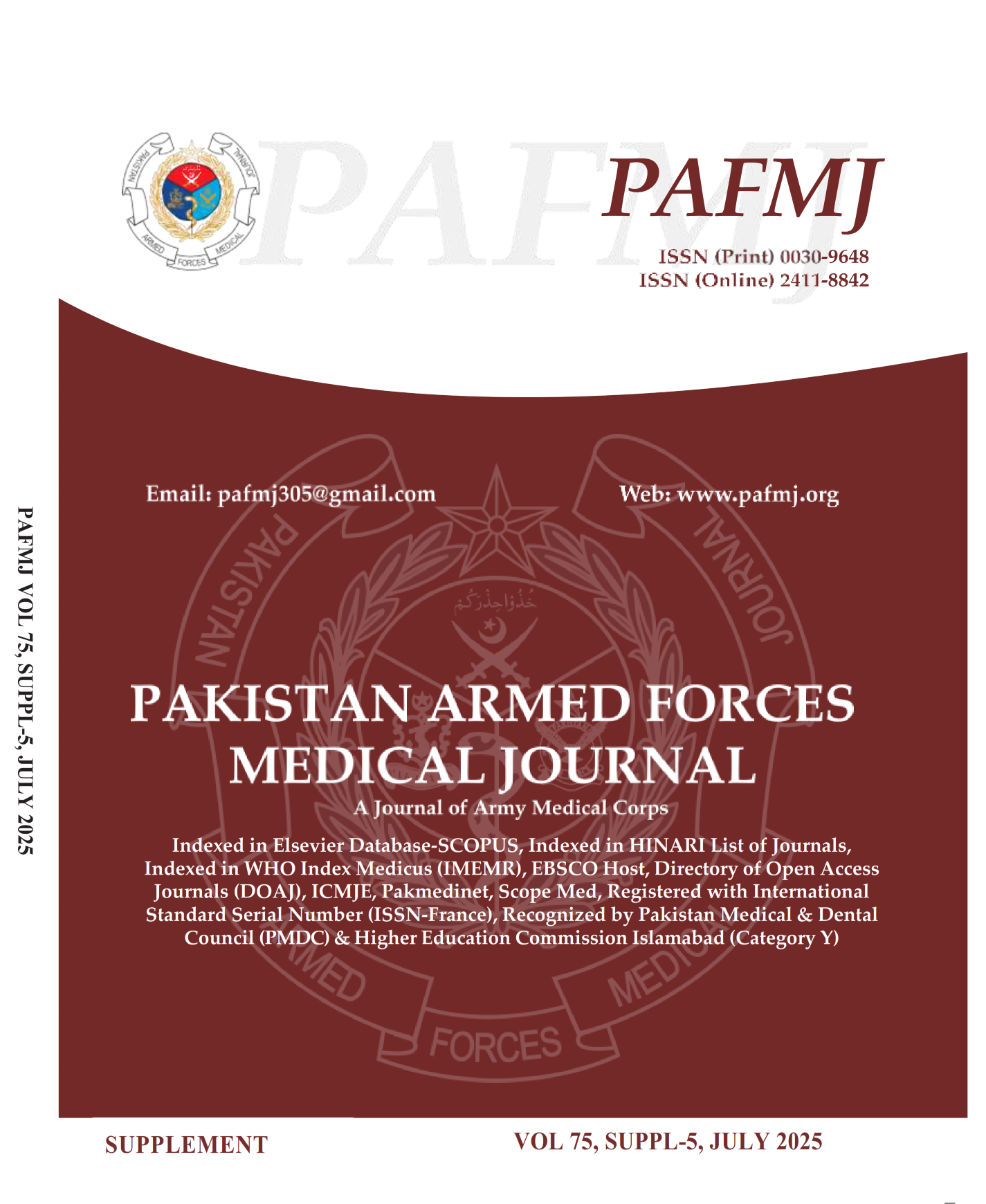Opportunistic Infection in HIV Patients at Tertiary Care Hospital in Rawalpindi
DOI:
https://doi.org/10.51253/pafmj.v75iSUPPL-5.12973Keywords:
Autoimmune deficiency Syndrome, Human immunodeficiency infection, Opportunistic Infection, Tuberculosis.Abstract
Objective: To determine the spectrum of opportunistic infection in human immunodeficiency virus patients at tertiary care hospital.
Study Design: Cross-sectional study.
Place and Duration of Study: Department of Infectious Diseases, Pak Emirates Military Hospital, Rawalpindi, Pakistan from Jan 2024 to Sep 2024.
Methodology: The confirmed cases of human immunodeficiency virus infection of both genders between the age of 18-65 years were included. Patients having any infection before the diagnosis of human immunodeficiency virus infection were excluded from the study. Moreover, those who were not willing to participate and unable to comprehend questions were also excluded. All participants willing to participate were interviewed for demographic details and the clinical examination was done afterwards. Laboratory investigations for the suspected opportunistic infections were done.
Results: Of these eighty-one (n=81) patients 74(91.36%) were males and 7(8.64%) were females with a median age of 29.00 (44.00-35.00) years. The median HIV RNA PCR value was 33000.00 (1529.00 - 903341.00) IU/ml while median CD4 counts were 213.00 (71.00-381.00) cell/mm3. The most common opportunistic infection was pulmonary tuberculosis 20(24.69%) followed by Cytomegalovirus infection 18(22.22%) and Toxoplasmosis 17(20.99%). Syphilis was seen in 7(8.64%) while Cryptococcal Meningitis was seen in 3(3.70%). The least common infections were hepatitis B and Ebstein Bar virus infection having a frequency of 1(1.23%).
Conclusion: Pulmonary tuberculosis, cytomegalovirus infection and toxoplasmosis were the most common infections observed in individuals with human immunodeficiency virus infection.
Downloads
References
1. Salman Y, Shaeen SK, Butt MS, Vohra LI, Hashmi T. HIV in Pakistan: Challenges, efforts and recommendations. Ann Med Surg (Lond) 2022; 84: 104797.
http://doi.org/10.1016/j.amsu.2022.104797
2. Muqtadir J, Sarfraz S, Salahuddin N. Factors Affecting Diagnostic Delay of Advance HIV Disease at Enrolment in the Indus Hospital, Karachi, Pakistan. Infect Dis J Pak 2022; 30(1): 4-8.
3. Ghate M, Deshpande S, Tripathy S, Nene M, Gedam P, Godbole S, et al. Incidence of common opportunistic infections in HIV-infected individuals in Pune, India: analysis by stages of immunosuppression represented by CD4 counts. Int J Infect Dis 2009; 13(1): e1-8.
http://doi.org/10.1016/j.ijid.2008.03.029
4. Aizaz M, Abbas FA, Abbas A, Tabassum S, Obeagu EI. Alarming rise in HIV cases in Pakistan: Challenges and future recommendations at hand. Health Sci Rep 2023; 6(8): e1450.
http://doi.org/10.1002/hsr2.1450
5. Kalavathi GP, Sagar H, Ravikumar BV. Clinical profile of symptomatic HIV infections at a tertiary care hospital. Int J Adv Res Med 2019; 1(2): 45-47.
6. Low A, Gavriilidis G, Larke N, B-Lajoie MR, Drouin O, Stover J, et al. Incidence of Opportunistic Infections and the Impact of Antiretroviral Therapy Among HIV-Infected Adults in Low- and Middle-Income Countries: A Systematic Review and Meta-analysis. Clin Infect Dis. 2016; 62(12): 1595-1603.
http://doi.org/10.1093/cid/ciw125
7. Department of Disease Control. Thailand national guidelines on HIV/AIDS treatment and prevention 2014. Agricultural cooperatives printing house of Thailand Co., Ltd.: Bureau of AIDS, tuberculosis and STDs; 2014. 498 p.
8. WHO. HIV in the WHO Eastern Mediterranean Region [Internet]. World Health Organization - Regional Office for the Eastern Mediterranean. Available from:
https://www.emro.who.int/asd/about/hiv-situation-region.html
9. Liu E, Makubi A, Drain P, Spiegelman D, Sando D, Li N, et al. Tuberculosis incidence rate and risk factors among HIV-infected adults with access to antiretroviral therapy. AIDS 2015; 29(11): 1391-9.
http://doi.org/10.1097/QAD.0000000000000705
10. Abdu M, Ali Y, Anteneh S, Yesuf M, Birhanu A, Mohamed S, et al. Determinant factors for the occurrence of tuberculosis after initiation of antiretroviral treatment among adult patients living with HIV at Dessie Referral Hospital, South Wollo, Northeast Ethiopia, 2020. A case-control study. PLoS One 2021; 16(3): e0248490. http://doi.org/10.1371/journal.pone.0248490
11. Boonnoi S, Tingpej P, Homkham N. Incidence and risk factors of opportunistic infections in HIV-infected adults on antiretroviral therapy. Sci Tech Asia 2022; 27(4): 58-68.
http://doi.org/10.14456/scitechasia.2022.67
12. Balkhair AA, Al-Muharrmi ZK, Ganguly S, Al-Jabri AA. Spectrum of AIDS Defining Opportunistic Infections in a Series of 77 Hospitalised HIV-infected Omani Patients. Sultan Qaboos Univ Med J 2012; 12(4): 442-8. http://doi.org/10.12816/0003169
13. Jaryal A, Raina R, Sarkar M, Sharma A. Manifestations of tuberculosis in HIV/AIDS patients and its relationship with CD4 count. Lung India 2011; 28(4): 263-266.
http://doi.org/10.4103/0970-2113.85687
14. Freeman ML, Lederman MM, Gianella S. Partners in Crime: The Role of CMV in Immune Dysregulation and Clinical Outcome During HIV Infection. Curr HIV/AIDS Rep 2016; 13(1): 10-9.
http://doi.org/10.1007/s11904-016-0297-9
15. Wesołowski R, Pawłowska M, Smoguła M, Szewczyk-Golec K. Advances and Challenges in Diagnostics of Toxoplasmosis in HIV-Infected Patients. Pathogens. 2023; 12(1): 110.
http://doi.org/10.3390/pathogens12010110
16. Ellis J, Cresswell FV, Rhein J, Ssebambulidde K, Boulware DR. Cryptococcal Meningitis and Tuberculous Meningitis Co-infection in HIV-Infected Ugandan Adults. Open Forum Infect Dis 2018; 5(8): ofy193.
http://doi.org/10.1093/ofid/ofy193
17. McHale TC, Boulware DR, Kasibante J, Ssebambulidde K, Skipper CP, Abassi M. Diagnosis and management of cryptococcal meningitis in HIV-infected adults. ClinMicrobiol Rev. 2023; 36(4): e0015622. http://doi.org/10.1128/cmr.00156-22
18. Ibrahim A, Chattaraj A, Iqbal Q, Anjum A, Rehman MEU, Aijaz Z, et al. Pneumocystis jiroveci Pneumonia: A Review of Management in Human Immunodeficiency Virus (HIV) and Non-HIV Immunocompromised Patients. Avicenna J Med 2023; 13(1):23-34.
Downloads
Published
License
Copyright (c) 2025 Mirza Waseem Javed, Shazia Nisar, Ejaz Ahmad, Muhammad Iqbal, Muhammad Anwar, Syed Yasir Abbas

This work is licensed under a Creative Commons Attribution-NonCommercial 4.0 International License.















